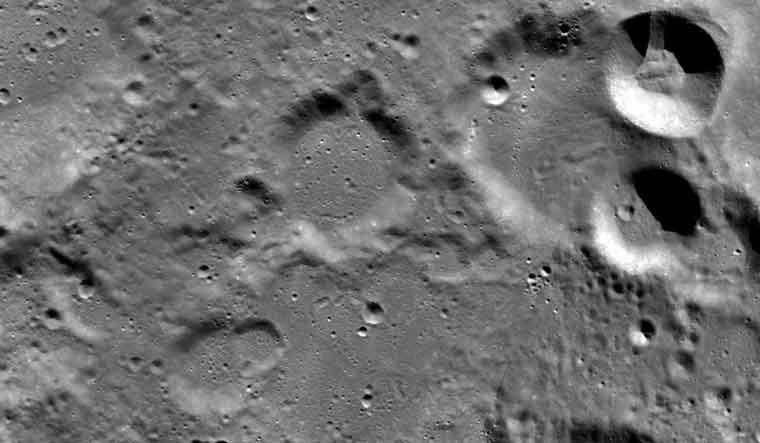
NASA on Friday released high-resolution images captured by its Lunar Reconnaissance Orbiter Camera (LROC) during its flyby of the lunar region, where India's ambitious Chandrayaan-2 mission attempted a soft landing near the Moon's uncharted south pole. It found Vikram had a hard landing.
The Vikram lander module attempted a soft landing on a small patch of lunar highland smooth plains between Simpelius N and Manzinus C craters before losing communication with ISRO on September 7.
"Vikram had a hard landing and the precise location of the spacecraft in the lunar highlands has yet to be determined, NASA said.
The scene was captured from a Lunar Reconnaissance Orbiter Camera Quickmap fly-around of the targeted landing site image width is about 150 kilometres across the centre.
Vikram was scheduled to touch down on September 7. This event was India's first attempt at a soft landing on the moon. The site was located about 600 kilometres from the south pole in a relatively ancient terrain, according to the US space agency.
The LRO passed over the landing site on September 17 and acquired a set of high-resolution images of the area; so far the LROC team has not been able to locate or image the lander.
LRO will next fly over the landing site on October 14 when lighting conditions will be more favourable, John Keller, Deputy Project Scientist Lunar Reconnaissance Orbiter Mission, Goddard Space Flight Centre, told PTI via email.
Over the last fortnight, both Chandrayaan 2's orbiter and NASA's Lunar Reconnaissance Orbiter have been trying to locate the lander. The Indian orbiter was at a great altitude—100 km—so despite the most powerful camera in a lunar mission ever, it has only captured a hazy image.
"It was dusk when the landing area was imaged and thus large shadows covered much of the terrain; it is possible that the Vikram lander is hiding in a shadow. The lighting will be favourable when LRO passes over the site in October and once again attempts to locate and image the lander," NASA said.
Chandrayaan-2 for India now means its orbiter, which is successfully orbiting around the moon in the intended orbit of 100 x 100 km. Though it was initially announced that its mission life would be for a year, ISRO subsequently said that it had enough fuel to last for another six. Most of the scientific instruments of the mission are on the orbiter. It is hoped that this mission will prove useful and additional to existing knowledge of the moon. In its last communication to the press, ISRO has said that all payloads of the orbiter are powered and initial trials have been completed successfully. Thus, their performance is satisfactory



No comments:
Post a Comment